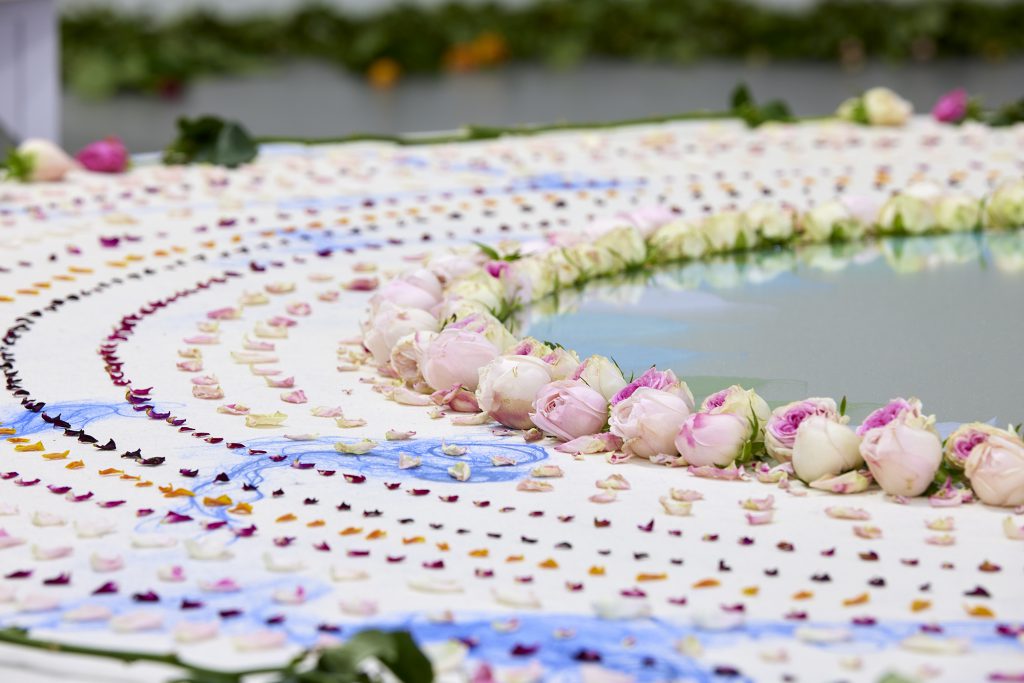
Chrysanne Stathacos, The Three Dakini Mirrors (of the body- speech and mind), 2021 Commissioned by the 13th Gwangju Biennale
Chrysanne Stathacos, The Three Dakini Mirrors (of the body- speech and mind), 2021 Commissioned by the 13th Gwangju Biennale

Trained as a printmaker, Chrysanne Stathacos has worked with textiles, painting and performance for four decades to manifest in her practice a feminist meditation on death and impermanence. Like many artists of her generation, her experience of mortality and loss was mediated by the outbreak of the AIDS pandemic and its attendant sense of existential fragility among artist communities in the early 1980s and through the 1990s. At that time, Stathacos was active in the Toronto and New York art scenes, where she became close with the collective General Idea and AA Bronson, with whom she has a lifelong artistic collaboration that lasts to this day. At the same time, her work came to reflect the sense of indelible loss from the death of many friends and artistic partners. She also began queering her paintings with symbols of fragility and love, like ivy leaves, hair, and condoms, and reclaimed Dadaist tactics for feminist artistic practice, with the creation of an alter ego that she named Anne de Cybelle. She also pioneered the use of video chat in the interactive work 1-900 Mirror Mirror (1993), in which the audience was confronted with their own image reflected in an infinity mirror while talking to the artist over videophone.
In the late 1990s, Stathacos approached Buddhism through an encounter with Jetsunma Tenzin Palmo, a feminist Buddhist nun whom she met while traveling in India. Tenzin Palmo helped Stathacos to finally connect to a female spiritual voice after years of cultivating interests in Tibetan Buddhism, shamanic healing, ancient Greek spirituality, and tarot reading. Today, Stathacos is the founding director of the Dongyu Gatsal Ling Initiatives, an organization dedicated to supporting Tibetan Buddhist women practitioners and their communities in the Himalayan border regions and eastern Tibet.
Stathacos’s Rose Mandalas are installations made of colored rose petals carefully arranged in concentric circles around mirrors that reflect the sky and allude to higher spiritual spheres. Stathacos’s process for making these works is a ritual meditation and offering to the universe. Throughout the duration of the exhibition, the mandala slowly comes apart as a measure of the transience of human and nonhuman life and a celebration of change as a principle of compassion and beauty. As a final act performed by Stathacos, the installation is destroyed, blown by the artist’s own breath in a cleansing ritual of end and renewal.
Chrysanne Sthathacos in conversation with Jetsunma Tenzin Palmo
Live event at Gwangju National Museum, 25 February, 2021
Questionnaire for the conversation
1. Can you tell us more about your observations on how discourses are shifting both in Buddhism and the world, regarding our relationship to acts of mourning and healing during the past year of Covid-19?
2. You have spoken often about having grown up as a spiritualist and seeing seances. How do Buddhist practices also intersect with the afterlives and ritual passages of the dead today.
3. Are we our ancestors? What are our bodies carriers of? How is your take on gendered dimensions as a leading figure for female practitioners?
4. Impermanence, transience, intention, importance of breath—tell us how you see Chrysanne’s rose mandalas mobilized on the spiritual sphere?
5. We are here in our current embodied state, for potentially caring for people who have moved beyond this stage. How can we improve our relationships with our ancestors? What should be our wishes for our future selves and incarnations.
6. The Temple at DGL Nunnery is unusual as it portrays female figures that are rarely portrayed in Buddhist art. As described in the nunnery’s website “Since this is a Nunnery, the inner decoration of the temple reflects female embodiments of Enlightenment – Tara, Vajrayogini and so on – and this is especially emphasized in the exquisite murals around the walls and the rounded stained glass windows. There are walls dedicated to senior nun saints surrounding Shakyamuni Buddha and Mahaprajapati who was the Buddha’s stepmother and the first nun. When people enter they immediately feel a sense of peace together with gentle but powerful feminine energy: they feel awed and uplifted. Can you speak more how your vision for the Temple came into being and the importance of building a temple in honor of lineage female figures in Buddhism.
7. You are quoted “I made the vow to be reborn in the feminine form until I attained enlightenment.” Can you tell us more about the circumstances, and your intention to restore the Togdema lineage, highly realized female practioners at DGL and how important that is to the lineage?
Chrysanne Stathacos, The Three Dakini Mirrors (of the body- speech and mind), 2021 Commissioned by the 13th Gwangju Biennale